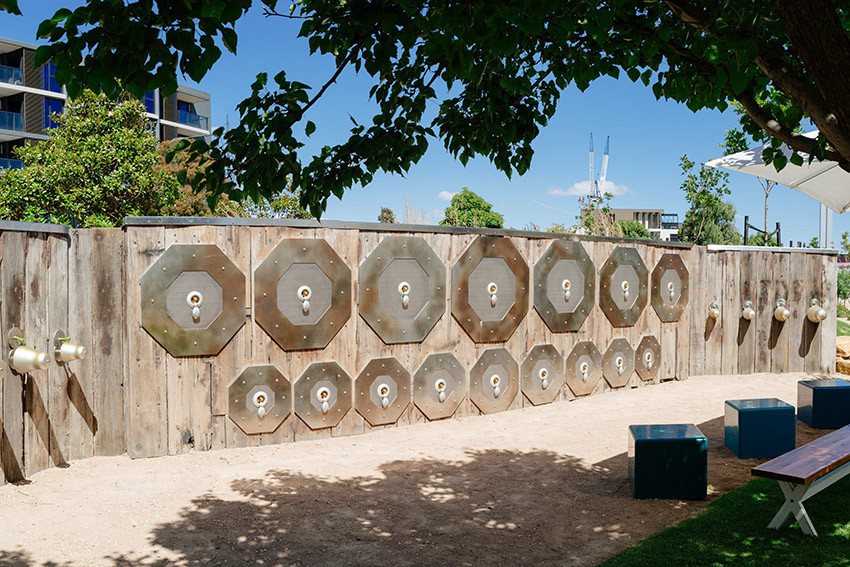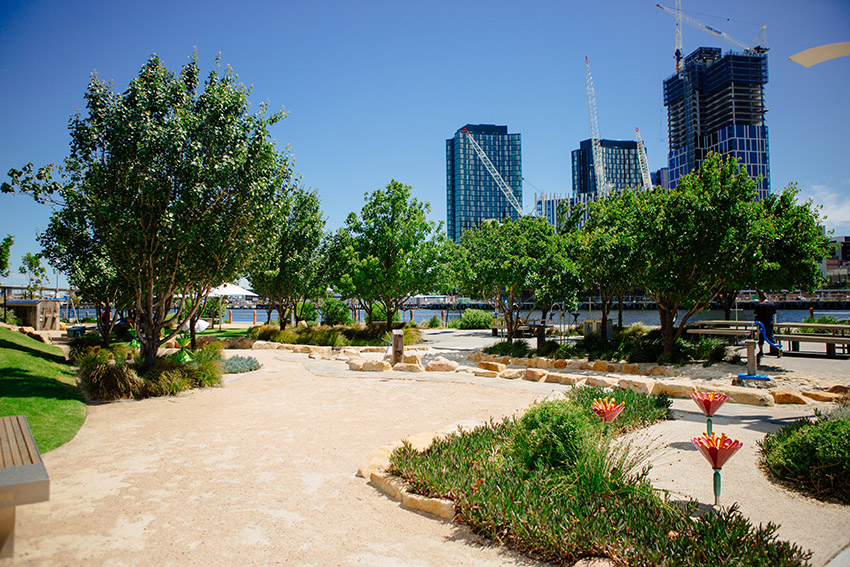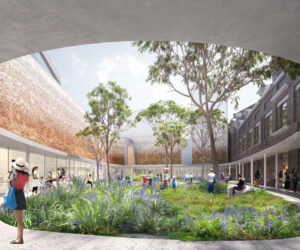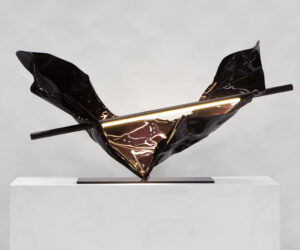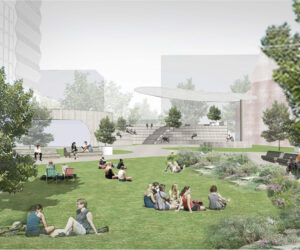Mirvac’s Harmony Garden
Melbourne’s first interactive playground where children can compose music using sculptural bells and gongs integrated into a playground environment has been revealed at Point Park, Yarra’s Edge, just moments from Melbourne’s CBD.
Mirvac’s Harmony Garden features 16 gongs, 19 instrumental bells and three percussion drums that combine to create an interactive musical instrument spanning 11 metres.
Designed by Neil McLachlan, the co-creator of Birrarung Marr’s famous Federation Bells, artist and sculptor Emilia Storm and landscape designer Simon Ellis, the Harmony Garden aims to encourage collaborative play between children.
After almost 18 months of planning, design and construction to create, the park’s unique music wall – consisting of gongs, drums and bells – is the first and only of its kind.
Constructed from timber, the large wall features 16 gongs made from stainless steel, which are tuned by a custom-made robot to produce a perfect harmonic tone. They’re also the first gongs engineered for western ears, as Asian gongs cannot play western-style harmonies, and sit alongside eight anodized aluminium harmonic bells and three cube drumming seats.
Dotted throughout the landscaped park are 11 multi-sensory interactive bell sculptures inspired by indigenous coastal plantings and situated within native gardens.
Mirvac’s Head of Residential, John Carfi, said the Harmony Garden will be a unique and fun way to bring children and adults together.
“The Harmony Garden allows people to create music from their surrounding environment, by themselves or with new friends they might meet at the park,” Mr Carfi said.
“We also see it as a fantastic way for parents and grandparents to interact with their young children as it is a lot of fun to collaborate on music together.”
“We think the Harmony Garden will become a destination playground in Melbourne, as there isn’t another one like it in the area. We have worked hard to ensure it won’t disturb local residents, engineering the bells and gongs to play soft sounds and orienting the site to minimise disruption,” said Mr Carfi.
Federation Bells co-creator, Neil McLachlan, also an Associate Professor at the University of Melbourne School of Psychological Sciences, said the park would encourage children to play cooperatively.
“Music is as important to mental health as sport is essential to physical wellbeing. Playing and listening to music has been proven to build confidence, resilience and improve language skills in children,” McLachlan said.
“Initiatives that encourage the creative integration of music into young lives in surprising new ways, such as through creative landscaping projects, is exciting. The Harmony Garden blends landscape architecture, sculpture and the science of music to create something very unique.”
The wider park includes more traditional play equipment such as swings, a double slide, carousel and a sand pit, while water features, including a stone water channel with hand pump, pay reference the Yarra River flowing past.
“We were very inspired by the waterside environment as well as the breezes associated with the river; this was what first motivated us to bring in such a strong musical element to the park,” landscape artist, Simon Ellis, said.
“The bells are nestled in sheltered spaces, while the vegetation has a freedom about it, referencing the wild nature of waterside and coastal areas. The water features promote unstructured play – kids can dam the water in the sand pit and get messy. We wanted the playground to be creative and artistic and therefore, not prescriptive.”
Sculptor, Emilia Storm, has brought a sense of the artistic to the site by creating sculptures that transform bells into playful and delicate artworks.
Each bell sculpture consists of one or more bells that have been individually hand-painted to produce luminous and intricate colours and patterns inspired by the surrounding Grass Trees, Grevillea, Banksia, Noone and Dianella flowers. Children use a specially-engineered colourful soft plastic stamen to play the bells.
“Everyone will enjoy interacting with the tactile, visual and sound qualities of the sculptures, while adults may also appreciate their abstract art qualities that create a sense of magic realism,” she said.
